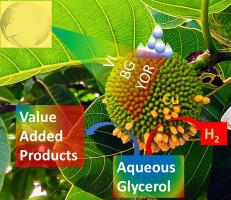Our official English website, www.x-mol.net, welcomes your
feedback! (Note: you will need to create a separate account there.)
Oxidative and selective C–C cleavage of glycerol to glycolaldehyde with atom-like Cu on Cu-TiO2: Photocatalytic water reduction with concurrent glycerol oxidation in sunlight
Journal of Catalysis ( IF 6.5 ) Pub Date : 2024-07-09 , DOI: 10.1016/j.jcat.2024.115644 Himanshu Bajpai , Thazhath R. Nivedhitha , Elsa Dais , Subhashree S. Kanungo , Chinnakonda S. Gopinath
Journal of Catalysis ( IF 6.5 ) Pub Date : 2024-07-09 , DOI: 10.1016/j.jcat.2024.115644 Himanshu Bajpai , Thazhath R. Nivedhitha , Elsa Dais , Subhashree S. Kanungo , Chinnakonda S. Gopinath

|
Concurrent consumption of electrons and holes for the conversion of a biomass component to value added products represents a highly efficient and sustainable approach towards utilizing renewable energy, but difficult to achieve. The integration of hydrogen production with glycerol oxidation presents a novel and sustainable approach towards achieving a circular economy. In the current study, integration of atom-like Cu-clusters onto TiO substrate has been achieved using a facile photo-deposition technique (TC-PDO). Also, novel synthetic approaches have been employed to augment the surface coverage of Cu on TiO with atom-like clusters of Cu, either by borohydride treatment on TiO followed by Cu-deposition (TC-200) or oxygen-vacancy creation by UV illumination followed by Cu-deposition (TC-PDO). Increased dispersion and enhanced electronic integration of Cu with TiO lead to a corresponding increase in the efficiency of photocatalytic hydrogen evolution (13.8 mmol/h.g for TC-PDO at pH 9). Several atom-like Cu integrated with each TiO particle acts as photocatalytic reactor, and the same enhances electron-hole separation as well as activity. Sustainable aspect was also studied for TC-PDO up to 25 h at pH 9. Concurrently, glycerol oxidation displays the highest selectivity to C2 product (glycolaldehyde with 70 %) with a C–C cleavage. The investigation of this process holds significant potential for the extensive and simultaneous exploitation of electrons and holes in order to achieve water splitting and glycerol oxidation towards selective value-added products formation.
中文翻译:

Cu-TiO2 上的原子状 Cu 将甘油氧化和选择性 C-C 裂解为乙醇醛:光催化减水,同时在阳光下甘油氧化
同时消耗电子和空穴以将生物质成分转化为增值产品代表了利用可再生能源的高效且可持续的方法,但难以实现。氢气生产与甘油氧化的结合为实现循环经济提供了一种新颖且可持续的方法。在当前的研究中,使用简便的光沉积技术(TC-PDO)实现了将类原子铜簇集成到 TiO 基底上。此外,还采用了新颖的合成方法,通过对 TiO 进行硼氢化物处理,然后进行铜沉积 (TC-200),或者通过紫外线照射产生氧空位,然后用类原子的 Cu 簇来增加 TiO 上 Cu 的表面覆盖率。通过铜沉积(TC-PDO)。 Cu 与 TiO 的分散性增加和电子集成增强导致光催化析氢效率相应提高(TC-PDO 在 pH 9 时为 13.8 mmol/hg)。每个 TiO2 颗粒上集成了多个原子状 Cu,充当光催化反应器,增强了电子空穴分离和活性。还研究了 TC-PDO 在 pH 9 下长达 25 小时的可持续方面。同时,甘油氧化对具有 C-C 裂解的 C2 产物(乙醇醛,70%)显示出最高的选择性。该过程的研究对于广泛且同时利用电子和空穴以实现水分解和甘油氧化以形成选择性增值产品具有巨大潜力。
更新日期:2024-07-09
中文翻译:

Cu-TiO2 上的原子状 Cu 将甘油氧化和选择性 C-C 裂解为乙醇醛:光催化减水,同时在阳光下甘油氧化
同时消耗电子和空穴以将生物质成分转化为增值产品代表了利用可再生能源的高效且可持续的方法,但难以实现。氢气生产与甘油氧化的结合为实现循环经济提供了一种新颖且可持续的方法。在当前的研究中,使用简便的光沉积技术(TC-PDO)实现了将类原子铜簇集成到 TiO 基底上。此外,还采用了新颖的合成方法,通过对 TiO 进行硼氢化物处理,然后进行铜沉积 (TC-200),或者通过紫外线照射产生氧空位,然后用类原子的 Cu 簇来增加 TiO 上 Cu 的表面覆盖率。通过铜沉积(TC-PDO)。 Cu 与 TiO 的分散性增加和电子集成增强导致光催化析氢效率相应提高(TC-PDO 在 pH 9 时为 13.8 mmol/hg)。每个 TiO2 颗粒上集成了多个原子状 Cu,充当光催化反应器,增强了电子空穴分离和活性。还研究了 TC-PDO 在 pH 9 下长达 25 小时的可持续方面。同时,甘油氧化对具有 C-C 裂解的 C2 产物(乙醇醛,70%)显示出最高的选择性。该过程的研究对于广泛且同时利用电子和空穴以实现水分解和甘油氧化以形成选择性增值产品具有巨大潜力。

















































 京公网安备 11010802027423号
京公网安备 11010802027423号